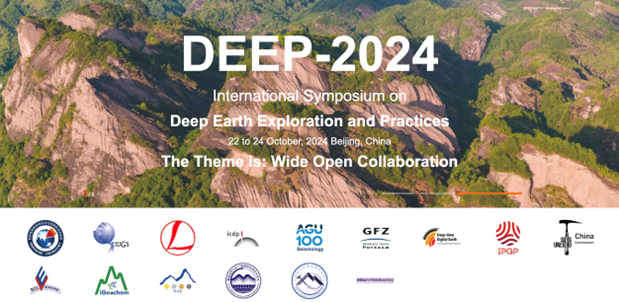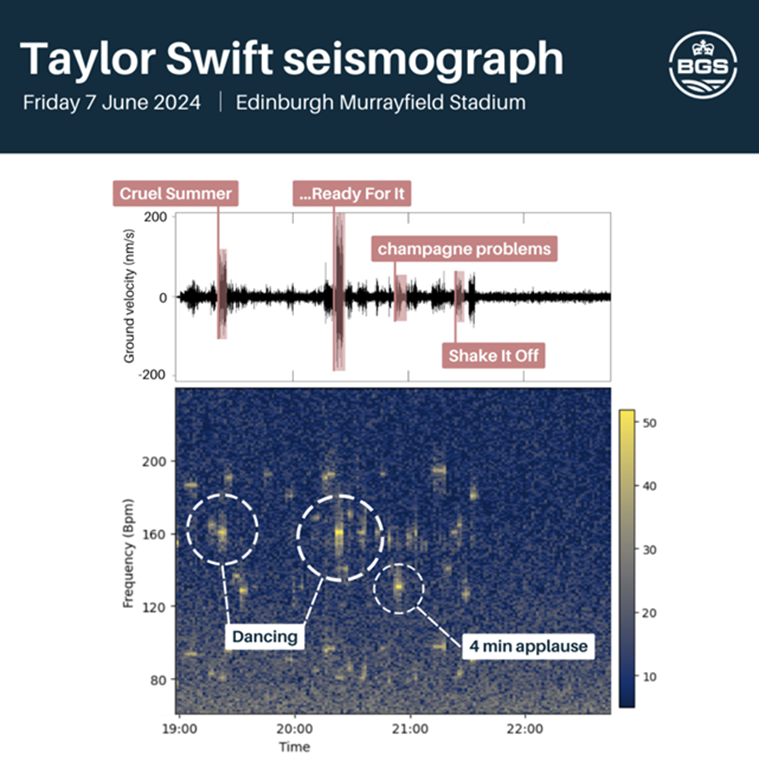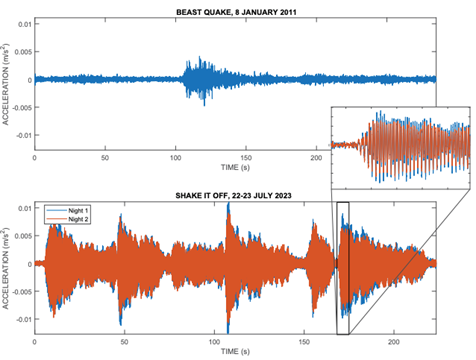| |
(7) AGU Seismology on LinkedIn
We invite you to join the AGU Seismology LinkedIn page by simply clicking on the following link: AGU Seismology LinkedIn Page. By joining the AGU Seismology LinkedIn group, you will:
- Connect with seismologists worldwide: Network with fellow researchers, students and professionals passionate about the science of earthquakes and Earth's interior.
- Stay ahead of the curve: Get the latest updates on cutting-edge research, industry trends and upcoming conferences and workshops in seismology.
- Engage in meaningful discussions: Share your knowledge, insights and experiences with a global community of seismologists and learn from their expertise.
Contribute to a vibrant community: Your participation strengthens our network, fosters collaboration, and expands our reach within the broader geoscience’s community.
|
| |
|
|
(8) Deep-2024 Sinoprobe Meeting to be held in 22-24 OctoberAfter the successful 2011 ISDEL, DEEP-2018 and DEEP-2021 meetings, that were attended by hundreds of geophysicists and geologists from the USA, Canada, Brazil, Russia, Australia, Japan, Germany, Italy, Spain, Sweden, Denmark, Turkey, Poland, UK, Ireland, South Africa, India, Singapore, etc., as well as China, DEEP-2024 is continuing more open and cooperation for global geo-community with the international family of attendees included principal and co-principal investigators of international deep exploration programmes, such as COCORP and EarthScope of the United States, LithoProbe and CCArray of Canada, AGCRC of Australia, and EuroProbe, TopoEurope, and AlpArray of Europe. Taking the opportunity of DEEP-2024, SinoProbe-II will host the launching ceremony with global partners. SinoProbe-II is looking for close international collaboration through the DEEP-2024 platform with SinoProbe Lab. Talent Boost Program, aiming for integration of exploration and research of critical geological study areas worldwide, and contributing to the international sharing of exploration data and results, with the overall objective of enhancing our knowledge of the Earth and its mineral resources.

|
|
|
| |
(9) 2025 AGU Honors Nominations
The nominations for AGU Union and section honors are currently being examined. If you missed out this year, please consider nominating people for awards and Fellows next year. The deadline for Union honors this year was 1 March: The nomination deadline for Fellows and Section Honors (Gutenberg Lecture, Keiti Aki Early Career Award, Silver Award, was 27 March. Next year’s timeline will probably be similar.
If you know of a deserving candidate but for some reason cannot nominate them, please feel free to contact any member of the Seismology Section Canvassing Committee listed below. If you don’t have time to nominate someone this year, it’s not too early to start thinking about next year!
2024 Seismology Section Canvassing Committee: Jay Pulliam (chair), Jeanne Hardebeck, Cesar Ranero, Anya Reading, Aaron Velasco, Lingling Ye
|
|
|
(10) Take a Survey About Sharing Community Science Resources
Do you work with communities? Do you want to share and publish your community science work? AGU’s Community Science Exchange wants to hear from you! Take their short, anonymous survey to tell them how you’d like to share your community science materials, to help inform development of a resource hub for scholars, community science stakeholders and practitioners, and more.
|
|
|
(11) Shaking Concerts: The Seismic Power of Taylor Swift’s Fanbase
Taylor Swift's recent concerts have captivated not only her fans but also the scientific community. Her performances, among others in Edinburgh and Seattle, produced seismic activities that have been carefully studied and documented. This phenomenon, colloquially termed "Swift Quake", provides an intriguing case study in human-induced seismicity.Seismometers are highly sensitive instruments capable of detecting even the slightest ground movements caused by various natural and man-made sources. Natural causes include wind, weather, ocean tides, and earthquakes, while human activities such as traffic, industrial operations, and large gatherings (notably, concerts!) also contribute to seismic background noise. Although earthquakes are a significant concern, they are relatively rare in the data captured by seismometers compared to the recorded activity that stems from non-seismic sources, illustrating the instruments' sensitivity to a broad spectrum of vibrations.Edinburgh Concerts: Dancing to the BeatOn 7th June 2024, the British Geological Survey (BGS) reported significant seismic activity during Taylor Swift's record-breaking Eras tour concerts at Murrayfield Stadium in Edinburgh. Seismometers around Edinburgh detected vibrations up to 6 kilometers (about 4 miles) from the venue, with the most notable readings occurring during the songs "...Ready For It?", "Cruel Summer," and "champagne problems." These readings were predominantly generated by fans dancing in sync with the music, reaching a peak at 160 beats per minute (bpm) during "...Ready For It?", transmitting about 80 kilowatts of power (roughly equivalent to the power of 10 to 16 car batteries). The seismic data indicated that the Friday night concert produced the highest level of activity, with a maximum ground motion amplitude of 23.4 nanometers (nm), compared to 22.8 nm and 23.3 nm on Saturday and Sunday, respectively. Figure 1: (Top) Seismograph showing ground velocity recorded 4 kilometers (about 2.5 miles) from the stadium and (bottom) spectrograph showing the power at each frequency (in BPM) during the Taylor Swift Eras concert in Edinburgh on 7 June 2024. (BGS, 2024).Seattle Concerts: Swift QuakeThe seismic activity recorded during Taylor Swift's concerts in Seattle was even more pronounced. According to seismologist Jackie Caplan-Auerbach from Western Washington University, the concerts at Lumen Field on July 22 and 23, 2023, generated seismic waves equivalent to a 2.3 magnitude earthquake. This level of seismic activity was comparable to the "Beast Quake" of 2011, caused by Seattle Seahawks fans celebrating a touchdown. The seismic patterns recorded during the concerts were almost identical on both nights, indicating a consistent setlist and fan behavior. The maximum ground acceleration reached approximately 0.011 meters per second squared (Caplan-Auerbach, 2023). This sustained seismic activity was attributed to a combination of the sound system and synchronized movements of the 70,000 fans present each night. Figure 1: (Top) Seismograph showing ground velocity recorded 4 kilometers (about 2.5 miles) from the stadium and (bottom) spectrograph showing the power at each frequency (in BPM) during the Taylor Swift Eras concert in Edinburgh on 7 June 2024. (BGS, 2024).Seattle Concerts: Swift QuakeThe seismic activity recorded during Taylor Swift's concerts in Seattle was even more pronounced. According to seismologist Jackie Caplan-Auerbach from Western Washington University, the concerts at Lumen Field on July 22 and 23, 2023, generated seismic waves equivalent to a 2.3 magnitude earthquake. This level of seismic activity was comparable to the "Beast Quake" of 2011, caused by Seattle Seahawks fans celebrating a touchdown. The seismic patterns recorded during the concerts were almost identical on both nights, indicating a consistent setlist and fan behavior. The maximum ground acceleration reached approximately 0.011 meters per second squared (Caplan-Auerbach, 2023). This sustained seismic activity was attributed to a combination of the sound system and synchronized movements of the 70,000 fans present each night.  Figure 2: Waveforms for the (top) 2011 Beast Quake and (bottom) the song “Shake It Off” from Taylor Swift concerts. The Beast Quake has a shorter duration and is ~2.5x weaker in amplitude. Waveforms for the song “Shake It Off” (blue and orange) are shown for two nights, offset in time to align the waveforms. (Caplan-Auerbach, 2023)Recent scientific research provides an in-depth analysis of the seismic activity generated by Taylor Swift's concerts. The study focused on her August 2023 concert at SoFi Stadium in Inglewood, California. Researchers deployed seismic sensors inside and near the stadium and used a Hough transform approach to identify and analyze the seismic signals. This study confirmed that the signals primarily resulted from crowd movements rather than the music itself. The structural response of the stadium showed nearly equal shaking intensities in both vertical and horizontal directions, correlating with the recorded seismic signals (Tepp, 2024) .ConclusionsSeismologists use ground acceleration and amplitude measurements to quantify the energy released during these events. The ground vibrations during the Seattle concerts were significant enough to draw comparisons to natural seismic events. However, unlike earthquakes, which involve deep geological movements and energy release, the "Swift Quake" was caused by surface-level activities. The repetitive, synchronized movements of the fans created a distinct seismic signature, characterized by harmonics that matched the beat rates of the songs performed. The "Swift Quake" phenomenon highlights the potential for large gatherings to produce detectable seismic activity. Widespread media attention to the "Swift Quake" and other related phenomena (e.g., 2011 “Beast Quake”) could incite scientific curiosity and encourage some young fans to pursue careers in seismology or related fields.In conclusion, Taylor Swift's concerts have demonstrated a unique interaction between human activities and natural phenomena. The detailed seismic analyses conducted in Edinburgh, Seattle, and Inglewood provide valuable insights into how large-scale human-induced groundshaking can influence the earth's surface. As researchers continue to explore this intersection, the "Swift Quake" serves as a compelling example of the unexpected ways in which our environment can be shaped by cultural events. Studying these phenomena not only makes science more accessible and engaging, but also could inspire the broader public and youth to take an interest in earthquake studies and related fields, fostering scientific curiosity and potential career interests in geophysics and seismology.ReferencesCaplan-Auerbach, J., Marczewski, K., & Bullock, G. (2023). Beast Quake (Taylor’s Version): analysis of seismic signals recorded during two Taylor Swift concerts.Tepp, G., Stubailo, I., Kohler, M., Guy, R., & Bozorgnia, Y. (2024). Shake to the Beat: Exploring the Seismic Signals and Stadium Response of Concerts and Music Fans. Authorea Preprints.British Geological Survey (BGS). (2024). "Seismic Activity from Taylor Swift Concerts in Edinburgh."BBC News. (2023). "Taylor Swift Seattle Concert Generates Seismic Activity." CBS News. (2024). "Taylor Swift concerts create seismic activity in Edinburgh, Scotland"New York Times. (2023). "‘Swift Quake’: Taylor Swift Fans Shake Ground During Seattle Concert."EOS. (2023). "Concerts and Seismic Activity: Analyzing the 'Swift Quake'." Caplan-Auerbach, J. (2023). Seismological Analysis of Taylor Swift Concerts. Tepp, G., & Colleagues. (2023). "Seismic Signals from Concerts: A Case Study of Taylor Swift's Performances." Seismological Research Letters. Figure 2: Waveforms for the (top) 2011 Beast Quake and (bottom) the song “Shake It Off” from Taylor Swift concerts. The Beast Quake has a shorter duration and is ~2.5x weaker in amplitude. Waveforms for the song “Shake It Off” (blue and orange) are shown for two nights, offset in time to align the waveforms. (Caplan-Auerbach, 2023)Recent scientific research provides an in-depth analysis of the seismic activity generated by Taylor Swift's concerts. The study focused on her August 2023 concert at SoFi Stadium in Inglewood, California. Researchers deployed seismic sensors inside and near the stadium and used a Hough transform approach to identify and analyze the seismic signals. This study confirmed that the signals primarily resulted from crowd movements rather than the music itself. The structural response of the stadium showed nearly equal shaking intensities in both vertical and horizontal directions, correlating with the recorded seismic signals (Tepp, 2024) .ConclusionsSeismologists use ground acceleration and amplitude measurements to quantify the energy released during these events. The ground vibrations during the Seattle concerts were significant enough to draw comparisons to natural seismic events. However, unlike earthquakes, which involve deep geological movements and energy release, the "Swift Quake" was caused by surface-level activities. The repetitive, synchronized movements of the fans created a distinct seismic signature, characterized by harmonics that matched the beat rates of the songs performed. The "Swift Quake" phenomenon highlights the potential for large gatherings to produce detectable seismic activity. Widespread media attention to the "Swift Quake" and other related phenomena (e.g., 2011 “Beast Quake”) could incite scientific curiosity and encourage some young fans to pursue careers in seismology or related fields.In conclusion, Taylor Swift's concerts have demonstrated a unique interaction between human activities and natural phenomena. The detailed seismic analyses conducted in Edinburgh, Seattle, and Inglewood provide valuable insights into how large-scale human-induced groundshaking can influence the earth's surface. As researchers continue to explore this intersection, the "Swift Quake" serves as a compelling example of the unexpected ways in which our environment can be shaped by cultural events. Studying these phenomena not only makes science more accessible and engaging, but also could inspire the broader public and youth to take an interest in earthquake studies and related fields, fostering scientific curiosity and potential career interests in geophysics and seismology.ReferencesCaplan-Auerbach, J., Marczewski, K., & Bullock, G. (2023). Beast Quake (Taylor’s Version): analysis of seismic signals recorded during two Taylor Swift concerts.Tepp, G., Stubailo, I., Kohler, M., Guy, R., & Bozorgnia, Y. (2024). Shake to the Beat: Exploring the Seismic Signals and Stadium Response of Concerts and Music Fans. Authorea Preprints.British Geological Survey (BGS). (2024). "Seismic Activity from Taylor Swift Concerts in Edinburgh."BBC News. (2023). "Taylor Swift Seattle Concert Generates Seismic Activity." CBS News. (2024). "Taylor Swift concerts create seismic activity in Edinburgh, Scotland"New York Times. (2023). "‘Swift Quake’: Taylor Swift Fans Shake Ground During Seattle Concert."EOS. (2023). "Concerts and Seismic Activity: Analyzing the 'Swift Quake'." Caplan-Auerbach, J. (2023). Seismological Analysis of Taylor Swift Concerts. Tepp, G., & Colleagues. (2023). "Seismic Signals from Concerts: A Case Study of Taylor Swift's Performances." Seismological Research Letters.
|
|